MyEnergi Eddi Review
Send spare solar power to your water heating, or take advantage of off-peak electricity




Verdict
The MyEnergi Eddi is a great idea if you want to make the most of an investment in solar panels or wind power. It works brilliantly, cutting your gas use and often treating you to a full tank of hot water, but its success is dependent on how much electricity you’re generating, and how much you’re using elsewhere in the home. Its boost functions – and particularly Budget Boost – can help you save even more, but they’re probably not reason enough to justify buying it if you don’t also have a source of green electricity such as solar panels.
Pros
- Supports home generation and load balancing
- Variable power diversion from 100W up to 3kW
- Powerful and reasonably easy app
Cons
- May need optional components for the best results
Key Features
- Automatic or scheduled water heatingThe Eddi diverts any spare solar energy into heating your water. It can be scheduled to use grid energy when it’s cheap, too
- App controlThe MyEnergi app helps you view and configure water heating. It also works with other MyEnergi products
Introduction
MyEnergi’s Eddi is called a solar power diverter, but in reality it’s a bit more flexible than that. A smallish metal box, it connects between your fuse board and an immersion heater, and can control the amount of electricity flowing to your water tank.
The Eddi is most useful for people with a variable form of home electricity generation, such as solar or wind. With the right connections, it can monitor the amount of energy flowing in or out of your home, and use any excess electricity to heat up a tank full of hot water. That’s not its only trick, however. The Eddi can be scheduled or configured to work with variable tariffs, meaning you may be able to get cheaper and greener hot water by using an overnight off-peak rate.
This belongs to a family of MyEnergi products designed to work together. As such, it goes well with the Zappi car charger or Libbi battery, all of which use the same app. But while it’s a little niche, it’s not unique – the Marlec Solar iBoost is a little cheaper and does much the same job. The Eddi comes with a three year warranty, which you can upgrade to five years.
Design and installation
- Professional installation needed
- Smart, rugged design
- Handy display
The MyEnergi Eddi is a fairly neat and compact unit, with a small backlit mono screen controlled by a few buttons. It can be fitted anywhere on the cable between your consumer unit (fuse box) and immersion heater, but there are a few considerations. Firstly, it needs a wired or wireless connection to the internet, and secondly if you have a source of generation, the Eddi needs to be able to measure how much power your home is importing from or exporting to the grid.
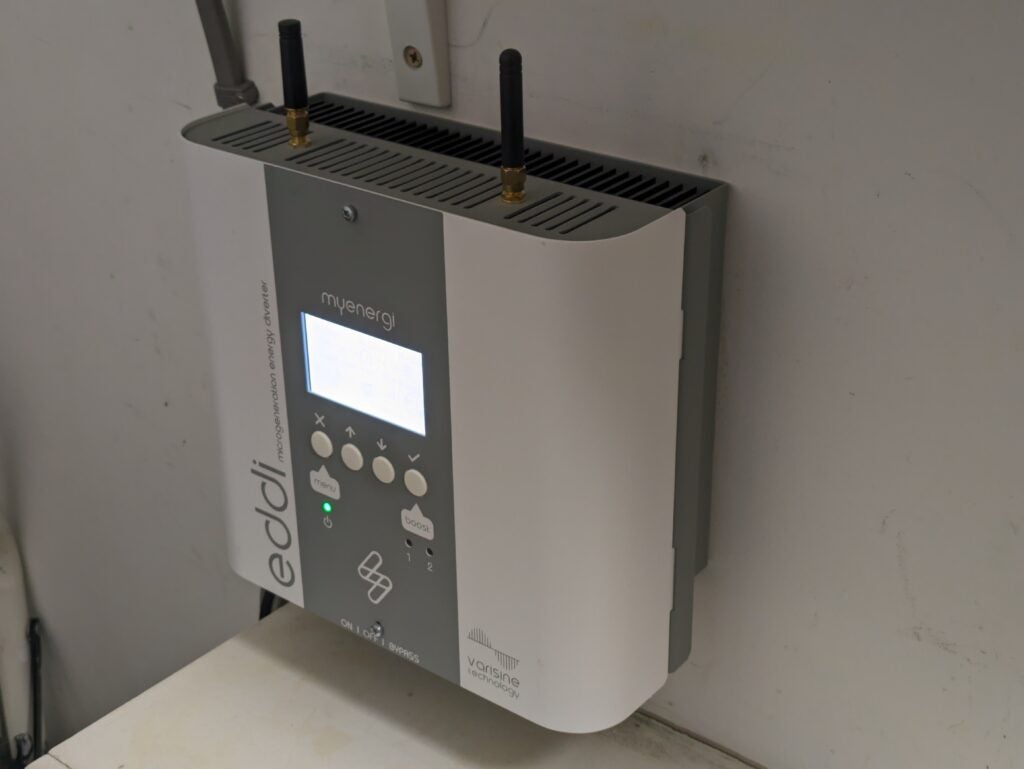
This can be achieved in a few ways. The Eddi comes with a CT (current transformer) clamp, which can be fitted around the main power cable entering your home. If you can’t or don’t want to run a cable, the optional Harvi hub provides a wireless alternative. With the CT installed, the Eddi knows if you’re exporting energy, and can ramp up its output so this spare power is used to heat water instead.
If you’re buying the Eddi as part of a wider MyEnergi installation, perhaps including the Zappi car charger, you can use a CT clamp connected to another device in the setup to measure grid usage. For example, in my system a CT connected to the Zappi measures grid performance, while the one on the Eddi monitors the output from my solar panels. This tells the system how much we’re taking or giving to the grid, and how much we’re generating at any given moment. The Eddi supports two CT clamps, so you can have it monitor both your grid and solar if that’s most convenient.
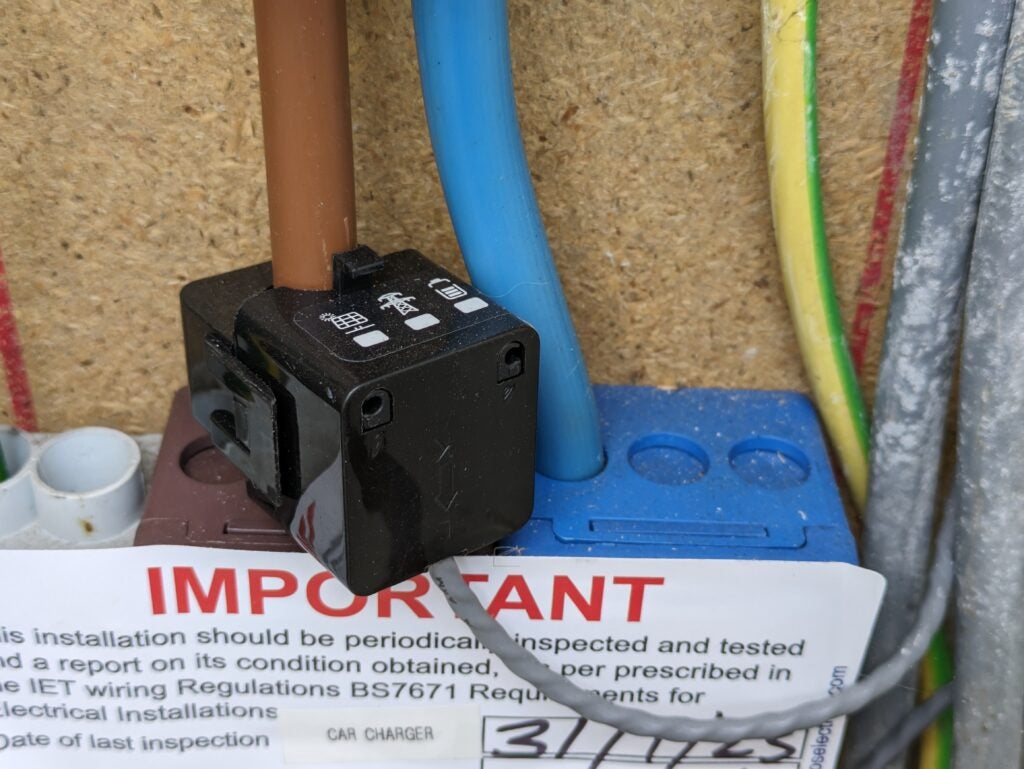
While I’m usually happy to connect various electrical devices, the Eddi is a job for the professionals. Any suitably qualified electrician can fit it, but you’ll get more help setting it up if you choose one who’s been trained by MyEnergi. If it’s part of a solar installation, you should also look for an MCS certified installer.
You can, in theory, use the Eddi to control two separate water tanks – or a compatible heater like the Everhot Electric Stove – but there are limitations. It’ll only power one device at a time, each with a maximum 3.6 kilowatt (kW) input. And because it works by varying the output power, it’s only suitable for ‘dumb’ loads – you can’t for example configure it to divert power to a washing machine or other appliance.
MyEnergy sells an optional relay and sensor board, which supports some more advanced installations. For example, this upgrade lets the Eddi work with some heat pumps, using spare power only until there’s enough for the heat pump to begin working, after which it will hand over. This combination also supports legionella control cycles, where a heat pump can trigger the Eddi to heat water to the higher temperatures needed to kill off any bacteria.
Core features
- Supports home energy generation
- Good control and data visualisations in the app
The main job of the Eddi is to help people make the most of their solar panels or other home generation sources. Because it usually costs more to import electricity than you can sell it for, it makes sense to use as much of your own electricity as possible rather than exporting it into the grid. As such, the Eddi keeps an eye on your grid connection, and when you start exporting power, it steps up its own power use to bring the export back down to zero. If you then start importing – say because you’ve turned a couple of lights on – the Eddi reduces its own power use until the house is again in balance.
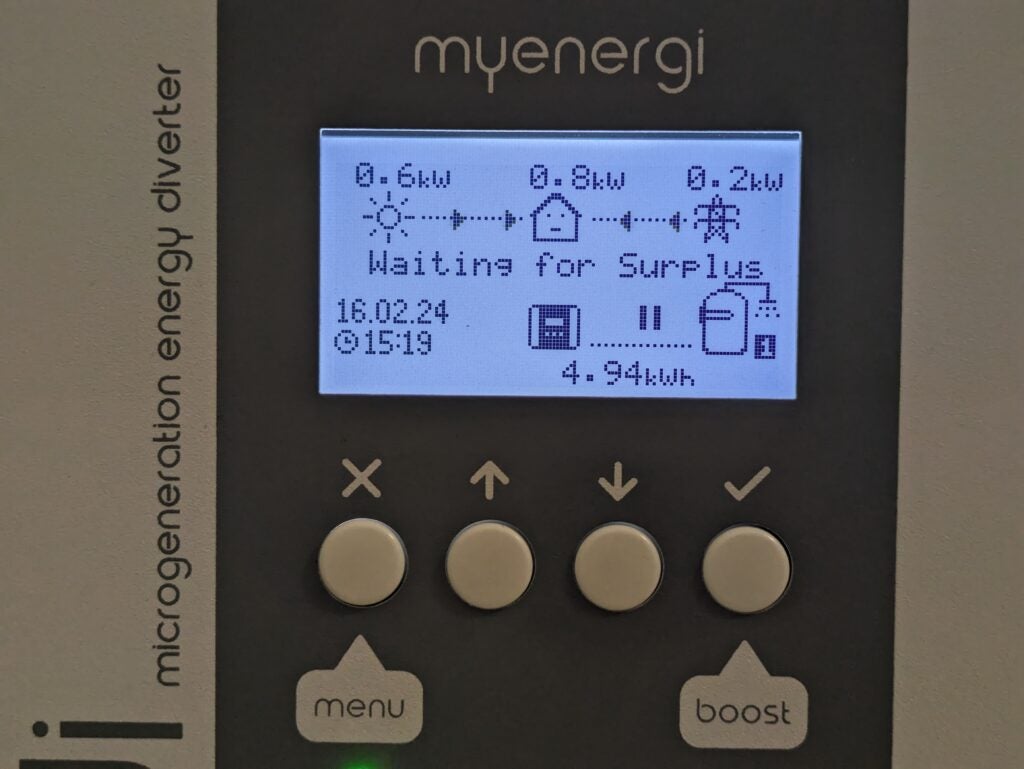
Depending on how much power you’re generating and using, the Eddi can vary the power it diverts to your hot water cylinder from just a hundred watts up to its 3.6kW maximum. In practice, a 3kW-rated immersion heater will draw a maximum of 3kW even when more power is available.
When the tank is up to temperature, its thermostat breaks the circuit and the Eddi stops sending power, which you can see happening at about 12:15 in the screenshot below. If the tank cools down or you run off some hot water, it’ll start heating again, which happened briefly at around 13:30.
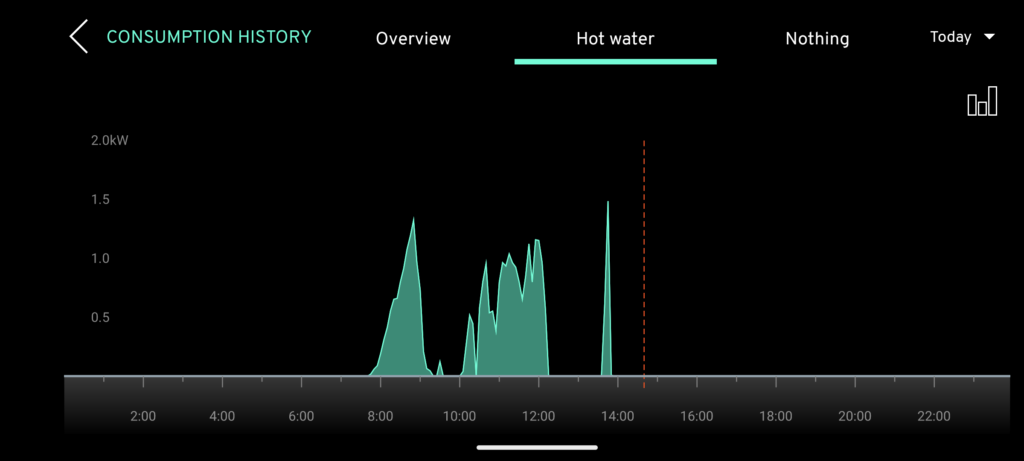
Diverting electricity in this way might result in a full tank of hot water before the end of the day which, compared to heating it with gas at the January 2024 price cap of 7p per kilowatt hour (kWh), could save you around 60p. Even on days without enough spare power to fully heat your tank, energy diverted by the Eddi will reduce the amount of mains electricity or gas you’ll need to finish heating your water. Quite apart from saving you money, that reduces the carbon impact of your hot water heating.
The Eddi can also ‘boost’ your hot water, heating it flat out with whatever electricity is available. That’s an essential feature if you don’t have an alternative heater such as a gas boiler, but it could also save you money. If you’re on an EV or time-of-use tariff where your off-peak electricity rate is the same or less than you pay for gas, it’ll be cheaper to heat with electricity – and you’re more likely to be using energy from low-carbon sources.
In practice, I’ve found the Eddi to do a great job of balancing electricity use in our home. On a sunny day, our solar panels will often generate enough spare electricity to heat a full tank of water – which takes about 8kWh. While this is happening, our smart meter usually shows that we’re neither importing nor exporting grid power. This might change momentarily if the sun goes behind a cloud, or we turn on a device, but balance is usually restored within 5-10 seconds. The savings have been significant: during the four non-heating months from May-August 2023, our family of four used just 360kWh of gas, worth about £30 in total.
MyEnergi’s app lets you keep an eye on your energy use and savings. Its excellent dashboard gives you a live picture of any generation, along with the energy being diverted to the Eddi and any grid imports and exports. You can also call up historical data for any previous day, or for the previous week, month or year. Selecting the Eddi itself lets you view its total energy use or, if it’s configured with two heaters, view each separately.
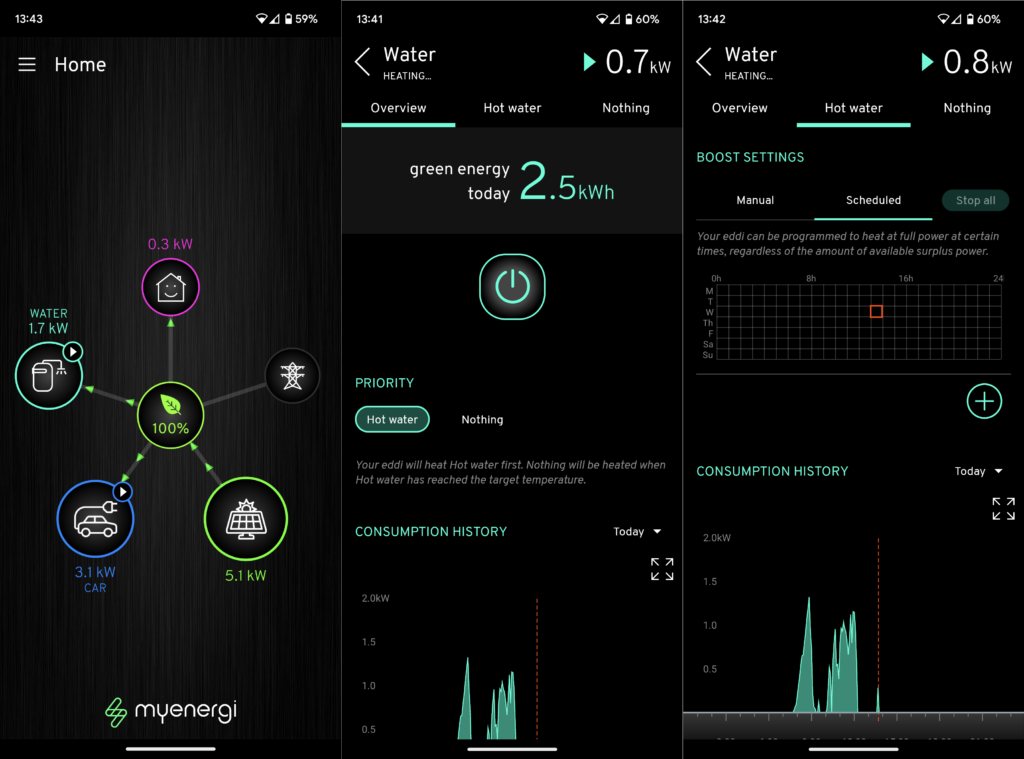
Advanced features
- Advanced scheduling features
- Fits in to the MyEnergi ecosystem
Strangely, for the easiest way to automate boosting you’ll need to ignore the app, create an account on the MyEnergi website, then tell it your energy supplier and tariff. Now you can use the website’s Budget Boost feature to set an electricity price below which your Eddi will automatically heat your water. This works for standard off-peak tariffs, but it’s ideal for variable, time-of-use tariffs like Octopus Energy’s Agile Octopus, which can occasionally go very low, or even pay you to use electricity.
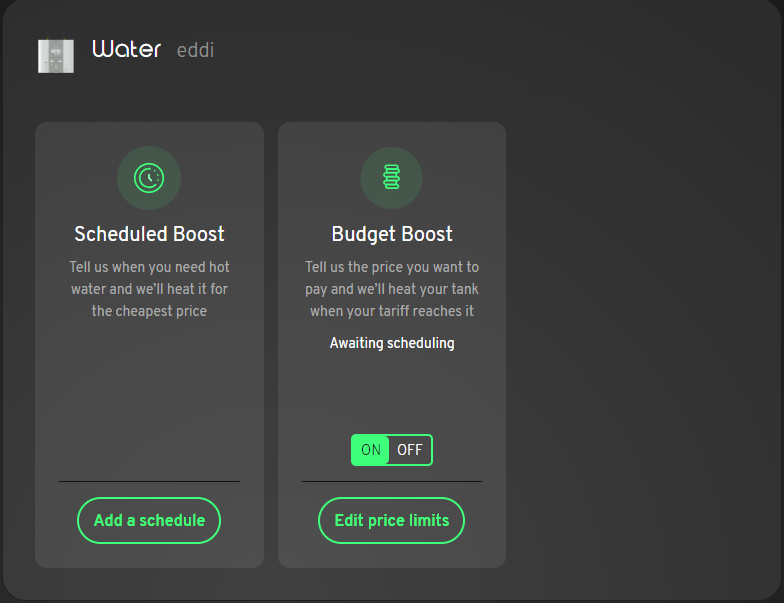
Users with home generation can use this feature to make the most of their investment by using a mix of their own energy and boosting to heat their water. Some users with good export rates and a variable import tariff may sometimes find they can buy electricity for less than they’ll be paid to export any surplus to the grid. Setting the Budget Boost threshold to your export rate means that the Eddi will use this cheap grid power, meaning that more of your own generation is spare to sell.
The Eddi works well on its own, but pairing it with the Zappi EV charger opens up new possibilities. The app lets you adjust priorities between the two, so that – for example – spare solar power is used to heat your water first, then charge your car later. If the car is the priority, the Eddi will use any spare power until there’s enough to meet the minimum 1.4kW required for EV charging, from which point the system will stop heating water and divert all spare power to the car.
The MyEnergi product family also includes the Libbi modular home storage battery. This is controlled via the same app, and can be prioritised in the same way. Give two or more devices equal priority and the spare power will be divided between them. However, unless you’ve got a big solar panel setup, you might find that they aren’t all fully heated or charged by the end of the day.
The Eddi will work around most other car chargers, even if it’s not strictly aware of them – it’ll just use any spare power it detects whether or not your car is charging. With third-party storage batteries, there’s a chance that the Eddi could interpret a tiny amount of power being exported while the battery discharges as spare energy from home generation. This could trigger a situation where the Eddi grabs all the power from the battery and exhausts its charge.
Fortunately you can configure an export threshold below which the Eddi won’t divert any power, which should prevent this problem. In some installations you could alternatively fit a CT clamp to the battery’s mains connection, giving the Eddi direct sight of the power flowing in and out of it.
Latest deals
Should you buy it?
Make the most of solar power
If you’ve got solar or wind power, the Eddi could give you plentiful hot water alongside money and carbon savings. It’ll let you benefit from cheap off-peak rates, too.
Best for homes with generation
While you can still use the Eddi with off-peak power, it probably won’t pay for itself if you don’t have a source of renewable energy.
Final Thoughts
As a solar-aware power diverter, the MyEnergi Eddi is something of a niche product. Designed to work with hot water cylinders, it can also play nicely with other low-carbon devices such as car chargers or – with an optional upgrade – a heat pump.
The Eddi isn’t dependent on home generation, thanks to its clever support for variable and off-peak tariffs. However, it’s most likely to save you money if you’ve got solar panels or some other form of micro generation, in which case it could cut your gas use dramatically – particularly in the summer months.
How we test
We test everything we review thoroughly over an extended period of time. We’ll always tell you what we find. We never, ever, accept money to review a product.
Find out more about how we test in our ethics policy.
Tested for more than 12 months
FAQs
You can wire the Eddi yourself, installing it in series with the immersion heater. Unless you’re a very confident DIYer, however, we’d strongly recommend getting an electrician to do it for you.
Hot water can be a great place to ‘store’ excess solar energy, particularly if you don’t have a battery or an EV to put it in. Depending on your use and how much solar you have, they could pay for themselves within a couple of years. However, some households can export solar electricity for more than they’d pay to heat water with gas or off-peak electricity. If that’s you, an Eddi might not save you as much.
An Eddi detects when you’re generating more power than you’re using, and diverts the spare energy into your immersion heater. That way you get free hot water.








